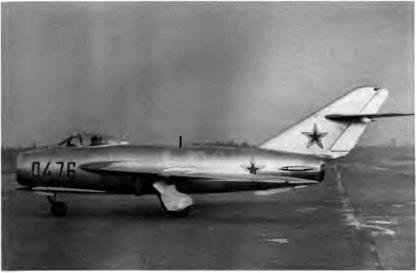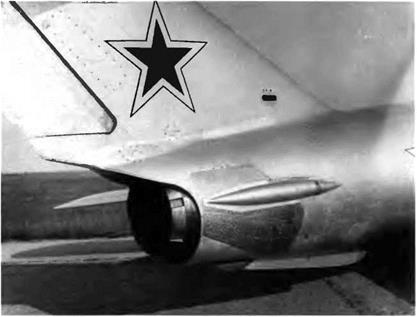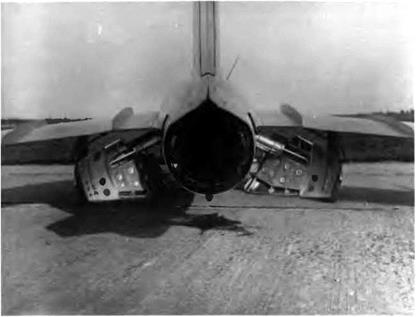MiG 17F / SF
Toward the end of the 1940s aircraft manufacturers began hunting for more powerful turbojets. The way the engines were positioned on the MiG-15 and MiG-17 posed an obstacle to any increase in thrust. It had become impossible to augment the pressure ratio with a centrifugal compressor distributing air to separated combustion chambers. On the other hand, it seemed impossible to increase the thrust of axial flow engines because the turbine blade temperature had already reached its upper limit.
|
The service life of the VK-1F afterburner was initially limited on the MiG-17F. |
With the help of the TsIAM, MiG engineers tried to obtain this thrust increase by burning fuel downstream from the turbine, an idea that proved to be the simplest and most efficient way to augment the nozzle exit impulse. The first homemade afterburner—together with its flame holder, its controlled fuel-air mixture light-up, and its adjustable nozzle—was designed and tested in the MiG OKB by a team managed by A. I. Komossarov and G. Ye. Lozino-Lozinskiy, who is presently responsible for development of the Buran space shuttle. At the time, reheat systems were not in use anywhere else in the world.
This afterburner consisted of a diffuser, the nozzle itself, and a variable exhaust nozzle breech with two open positions, 540 and 624 mm (21.26 and 24.57 inches). The basic nozzle subassembly consisted of the flame holder (a U-shaped ring) and the burner manifold. Trials and adjustments of the afterburner were earned out on TsIAM test benches, and the final product boosted engine thrust by 25 percent. The VK-1A with its afterburner was renamed the VK-1F. Its maximum diy thrust was 2,250 daN (2,600 kg st), a figure that rose to 3,310 daN (3,380 kg st) with reheat. The afterburner was internally cooled by forced convection of a part of the airflow from the engine intake ducts. The first production MiG-17 equipped with the VK-1F was no. 850. A few minor modifications had to be made in the engine bay to install the afterburner. The fuel system piping also had to be modified to take into account the significant increase in fuel flow and consumption caused by the reheat system.
|
MiG-17 no. 850 was reengined with the first VK ] F, thereby becoming a MiG-17F Note the sizable fairing of the airbrake lever. |
Factory tests on the SF started on 29 September 1951 with A. N. Chemoburov at the controls. Other О KB pilots such as G. A Sedov and К. K. Kokkinaki also took part, and the tests ended on 16 February 1952. The SF was then passed to the GK Nil VVS for state trials. Mass production of what became known as the MiG-17F was launched at the end of 1952 At first, use of the afterburner was limited to just three minutes at altitudes up to 7,000 m (22,960 feet) and ten minutes above that Equipment included the R-800, RSIU-3M, or RSIU-4V VF1F; the SRO-1 IFF transponder; the OSP-48 ILS with the ARK-5 ADF, the MRP – 48P marker receiver, and the RV-2 radio-altimeter; the ASP-4NM gun – sight; the FKP-2 monitoring camera; the S-13 camera gun; the KSR-46 flare launcher; the GSR-3000 generator; the 12 SAM25 accumulator bat – tery; and the RD-2ZhM pressure control unit. During its state trials, a number of difficult maneuvers were carried out with the afterburner in full operation.
In the course of their service life, the MiG-17Fs underwent many modifications. In November 1953 the first turbine cooler unit fitted with an automatic temperature regulator was installed in the aircraft to improve the pilot’s working conditions. Drop tanks with a capacity of 600 1 (158 US gallons) were considered, but only a few were built. In early 1953 production MiG-17Fs were fitted with a collector tank to
|
The exhaust nozzle breech and fully deployed airbrakes of the MiG-17F. |
feed the engine in negative-g flight conditions despite the fuel flow-rate increase when operating the afterburner. To reduce the pressure drop, this tank was fitted with six additional nonreturn valves. This delivered a reliable supply of fuel to the engine and the afterburner in inverted flight for at least five seconds.
The armament of the MiG-17F included one N-37D cannon with forty rounds and two NR-23s with 80 rpg. For its ground-attack role the aircraft could carry under its wing four 190-mm TRS 190 or two 212- mm ARS 212 air-to-surface rockets, or two rocket pods; or two 50-kg (110-pound), 100-kg (220-pound), or 250-kg (550-pound) bombs.
The MiG-17F could nearly break the sound barrier in level flight. Its revolutionary engine thrust augmentation device, the afterburner, would soon be adopted the world over. This model was also built in Poland, where it was called the LIM-5M.
Specifications
Span, 9.628 m (31 ft 7 in); overall length, 11.264 m (36 ft 11.5 in); fuselage length, 9.206 m (30 ft 2.4 in); height with depressed shock absorbers, 3.8 m (12 ft 5.6 in); wheel track, 3.849 m (12 ft 7.5 in); wheel base, 3.368 m (11 ft 0.6 in); wing area, 22.6 m2 (243.3 sq ft); takeoff weight, 5,340 kg (11,770 lb); max takeoff weight, 6,069 kg (13,375 lb);
fuel, 1,170 kg (2,578 lb); max landing weight, 4,164 kg (9,177 lb); wing loading, 263.3-268.5 kg/mz (54-55 lb/sq ft); max operating limit load factor, 8.
Performance
Max speed, 1,100 km/h at 3,000 m (594 kt at 9,840 ft); with reheat, 1,145 km/h at 3,000 m (618 kt at 9,840 ft), 1,071 km/h at 10,000 m (578 kt at 32,800 ft); max speed at sea level, 1,100 km/h (594 kt); max speed with two 400-1 (106-US gal) drop tanks, 900 km/h (486 kt); max permissible Mach, 1.03 (increased in 1954 to 1.15 at altitudes above 7,000 m [22,960 ft]); climb rate at sea level, 65 m/sec (12,800 ft/min); climb to
5,0 m (16,400 ft) in 2.4 min (2.1 min with reheat); climb to 10,000 m (32,800 ft) in 6 2 min (3 7 min with reheat); climb to 14,000 m (45,920 ft) in 14 min (6.3 min with reheat); takeoff speed, 235 km/h (127 kt); landing speed, 170-190 km/h (92-103 kt); range at 12,000 m (39,360 ft) with reheat operating to reach 3,000 m (9,840 ft), 1,160 km (720 mi); range at 12,000 m (39,360 ft) with two 400-1 (106-US gal) drop tanks, 2,020 km (1,255 mi); range at 12,000 m (39,360 ft) with two 400-1 (106- US gal) drop tanks and reheat operating to reach 3,000 m (9,840 ft), 940 km (584 mi); flight endurance at 12,000 m (39,360 ft), 1 h 52 min (1 h 40 min with reheat); flight endurance at 12,000 m (39 360 ft) with two 400-1 (106-US gal) drop tanks, 3 h; service ceiling with reheat, 16,600 m (54,450 ft) (at that altitude, prototype no. 850 still had a climb rate of 3 6 m/sec [710 ft/min]); service ceiling without reheat, 15,100 m (49,530 ft); takeoff roll, 590 m (1,935 ft); landing roll, 820-850 m (2,690-2,790 ft).













